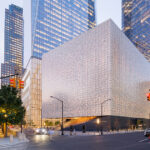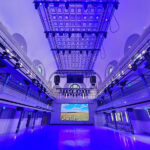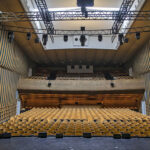Howard Ungerleider is one of the best LDs in our industry. He has a very distinguished career, having worked with bands such as Rush, Def Leppard and Queensrÿche. In addition, he has been involved with everything from corporate auto shows and interactive design to architectural multimedia shows, as well as theatrical productions, motion pictures, rock videos, nightclubs and television commercials. Howard is purely an LD and does not program his own consoles — he always works with a programmer.
His history with various programmers and his working knowledge of lighting productions began in 1971, when he was an office boy for American Talent International, an agency that represented dozens of touring groups in New York City. He was soon promoted to talent scout, and at 20 years old, he was traveling with famous groups making sure that the contracts he negotiated were being fulfilled. This worked well for Howard, as he had been interested in rock show lighting and special effects since he was a teenager.
Since he was close to the bands, they often asked him about their shows. His honest answers led him into a whole other world, as the general queries started turning into production questions like, “How can we make our show more interesting?” That is when all of his dreams started to develop, and he decided to help these artists improve their onstage appearance. He left ATI in the summer of 1974 after the agency sent him to Canada to run the touring operation for Rush.
In 1985, after exhausting the possibilities in the use of conventional lighting, he began designing with automated lighting, including work he did for the Def Leppard Hysteria tour in 1986, where he used a Vari*Lite rig. (That was an amazing show — I actually recall attending it as a teenager!) Today, most of his productions use about 120 moving fixtures, along with an assorment of conventional equipment, “but it’s relative to my clients and what they can afford,” he says.
Howard likes to work with programmers with whom he feels comfortable and who know what he expects from them within the course of a 14-hour day. He uses about five different programmers, all of whom he feels are “quality people.” He usually lets the programmer select his own board. However, when Howard chooses to run the show, then he personally will select the console, along with a programmer who feels comfortable behind it. When it comes to setting up the console and patch, Howard defers to his programmer. He also lets his programmer and head electrician determine the fixture numbering to be used within the console. He prefers to start by fixture type and usually starts downstage L–R to upstage L–R.
“I love to have an ‘analog feel’ to my show along with the main cue list,” he says. He accomplishes this by running each song in an individual page and then overriding the main cue list with an expansion wing. During cue creation, he visualizes in his mind the cues and works to translate them to his programmer in a timely fashion. “This way, we don’t dwell on intricate details until we have the backbone of the song created.” In advance of each song, Howard creates this backbone by taking the music track and dividing it into verse, chorus and bridge and by inputting this into cues. Once the backbone is created, then he begins the detailing and continues until the track is completed.
It is important to Howard to work with a programmer so that the flow of ideas isn’t interrupted. For that reason, he feels there is nothing better than a great programmer. “When I’m creating a show and having an idea flow, there is nothing more distracting than a programming problem or syntax discrepancy to throw off my creativity. Having another person to deal with this for me becomes a great luxury since they will fix the problem, and my ideas will not be affected.”
Once the initial cue creation period ends and a show is touring, Howard always has an assistant programmer who travels as part of the lighting crew. While Howard is directing and running the show, this programmer assists by editing cues as well as by helping to maintain the show’s integrity. “Each song has its own page of cues, and all of the manual cuing is done on an expansion wing,” Howard says. “I like to use auto follows on the main cuelists so that I can add to them manually via playbacks on the expansion wing.”
Howard has certain colors he enjoys using, along with custom color creations tailored for each production. “I prefer to use saturates along with key light colors. This makes for a vivid color scheme,” he says. “This is a time when having a programmer who is familiar with my needs is very bene-ficial. My favorite colors are 079, R22, 158, 106, 877, 839, 717 and on and on and on!”
Through the years, Howard has worked with many programmers at different levels of skill. He recounts that his worst experience was with a pro-grammer who was unaware of how to make the console do what he wanted. “This programmer had such a difficult time that he started crying, ex-perienced a nervous breakdown and had to be sent away for medical treatment,” Howard relates. “I was very lucky because, after that, they sent in one of the console developers, and he actually got it to work. All was good in the end.”
Of course, Howard also has had many sucessful experiences with programmers. He stresses that a programmer should have a complete knowledge of the capabilities of the board “so that we can push its boundaries.” He explains, “I like programmers who have a complete knowledge of all of the latest consoles and are masters in their syntax. For me, a good programmer must be friendly, loyal, a nonsmoker, open-minded, hygienically conscious and, most of all, not argumentative. A great sense of humor is mandatory.”
In addition to designing and operating a large number of productions and tours, Howard is very proud of a particular lighting moment in 1972. He attended a Marine auction and found a case of lamps called Marine Beacon Lights. They were 13-volt lamps the same size as a parcan. He put the lamps into parcans and wired eight of them in a series. “I found a smoke machine, and before my eyes I saw an amazing beam of light that appeared narrow, yet had a long throw.” He instantly thought, “Wow!” as he realized that he had created his own new fixture, now known as the ACL fixture.
Howard is a very thoughtful person, and he wouldn’t think of ending an interview without first thanking the programmers who “helped bring to fruition my creativity,” including Tim Grivas, Matt Tucker, Errol Reinart, Gary Wilson, John Popowycz, Scott Wilson, Alex Donne, David Hall and Ben Lueng. He is also very proud of his company Production Design International Inc. and his partners Brian Beggs and Louis Chu. You can learn more about Howard and his company at www.pdifx.com.
Brad Schiller can be reached at bschiller@plsn.com.


